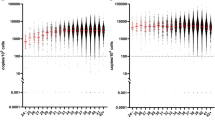Abstract
In this paper β-globin gene mutations were detected in 452 β-thalassemia carriers from 13 462 unselected individuals (6731 pregnant women and their husbands) who were screened for the β-thalassemia trait in the Guangzhou area of China. The incidence of β-thalassemia was calculated as 3.36%. This is higher than found in previous studies performed in southern China. Using reverse dot blot analysis, we found 11 types of mutations and identified the mutations in 446 (98.7%) of the 452 cases. Direct sequencing was carried out on the 6 unknown alleles, and a novel amber mutation in a β0-thalassemia gene (β37TGG→TAG) was found in one of them. Thus, the prevalence and spectrum of β-thalassemia mutations were obtained for this region. Twelve couples were detected at risk for thalassemia, and prenatal diagnosis was carried out in 11 of them. This is the largest number of Chinese subjects studied by DNA analysis to date and is the first report on the prospective diagnostic trial for β-thalassemia in a Chinese population. In addition, we have performed 80 prenatal diagnoses based on screening for β-thalassemia retrospectively.
Similar content being viewed by others
Author information
Authors and Affiliations
Additional information
Received: 17 November 1995 / Revised: 18 March 1996
Rights and permissions
About this article
Cite this article
Xu, X., Liao, C., Liu, Z. et al. Antenatal screening and fetal diagnosis of β-thalassemia in a Chinese population: prevalence of the β-thalassemia trait in the Guangzhou area of China. Hum Genet 98, 199–202 (1996). https://doi.org/10.1007/s004390050190
Issue Date:
DOI: https://doi.org/10.1007/s004390050190




